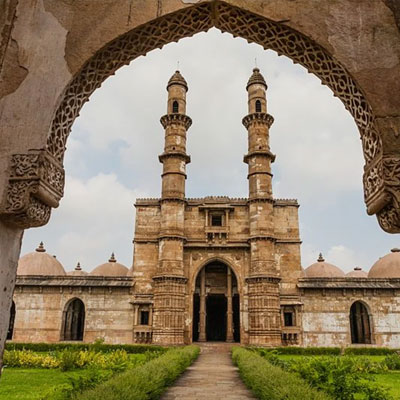Champaner-Pavagadh Archaeological Park - Gujarat
As a UNESCO World Heritage Site, Champaner and Pavagadh together is celebrated as the most unique historic destinations of Gujarat.
While Pavagadh resides at the hilltop over the widespread monuments with their base as Champaner. As a Duo, Champaner-Pavagadh is an
opulent heritage site lined up with mosques, forts, tombs, monuments, temples, arches, fortresses, and stepwells from the 8th century
to 15th century. Kalikamata Temple is a place of worship that has been frequented by plenty of pilgrim travellers and the presiding
deity is Goddess Kali. The exclusively unchanged Islamic-Mughal city after these years is Chamapaner. That’s why it is unspoiled and has the flavour of the Mughal architecture throughout its territories. Kalikamata Temple
juxtaposes this zone on the Pavagadh Hill and during Navratri thousands of people gather for spiritual bliss. The prayer hall has two tall central minarets, further superb stone carving, multiple domes, finely latticed windows
and seven mihrabs (prayer niches) along the back wall.The citadel which has staggering features connects two of the popular
religions in the world, Hinduism and Islam. The confluence of their architecture forms the crux of Champaner’s citadel.
There are even mosques of the 16th century but are currently unused for prayers. At the east gate of the Citadel, the enormous
Jama Masjid proudly presents the indomitable entrance porch leading into an adorable courtyard encompassed by a well-supported corridor. Two imposing central minarets, stone carvings, plenty of domes, finely gridded windows, and 7 Mecca oriented prayer niches forming the
front of the prayer hall which is called mihrabs in Arabic. All pointing toward Mecca with the divine Qibla Wall. As Chauhan Rajput’s capital
in 1300, Pavagadh was soon besieged by Sultan Mahmud Begada of Gujarat. After facing a severe 20 months of siege, Rajputs committed mass
suicides called Jauhar as they were on the verge of defeat. It became the new royal capital city after the Gujarat Sultan took over.
Later, Humayun around 1535 again decided to revert the capital to Ahmedabad and so the glory of Champaner got bruised a bit due
to non-commitment. 
How to reach Statue of Unity, Champaner-Pavagadh Archaeological Park
Train : Lying on the busy Mumbai-Delhi Western Railway Mainline, Vadodara connects premium trains like Rajdhani and Shatabdi.
Air : Vadodara airport is the nearest airport and is well connected with the rest of India.
Road : Vadodara is well connected to Vadodara through NH8 and the statue is just 90 km from Baroda and present in Kevadia which is under 5 km from the actual site